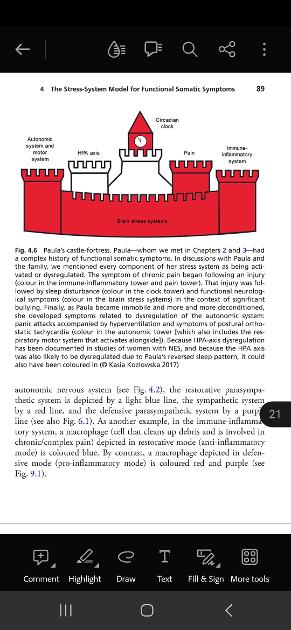Loved this article and its metaphors:
The stress system is made up of multiple interconnected brain-body systems—the autonomic nervous system, hypothalamic-pituitary-adrenal (HPA) axis, immune-inflammatory system, and brain stress systems underpinning salience detection, arousal, pain, and emotional states. These systems form part of a larger, integrated system that protects the individual from a broad range of threats
The Stress System Stuck in Defensive Mode.
Unfortunately, when stress is chronic, uncontrollable, unpredictable, cumulative, recurrent, or overwhelming—and the stress system is activated too much, too long, or too frequently—the stress system can get stuck in defensive mode (see Fig. 4.3, Frame B). When that happens, the stress system remains activated or, as it were, switched on.
researchgate.net/publicatio...
A couple of extracts:
"The child’s body told a different story. The body’s story suggested that each stress had switched on the child’s stress system. With each new stress, the stress system had been activated more and more, and was less and less able to turn itself off. The story that had begun with one functional somatic symptom was now a story of many different symptoms."
"Although the children and their parents typically told me that they were psychologically and emotionally unmarked by the adverse life events that they had experienced, I felt unconvinced. Likewise, although the paediatricians who referred children for treatment of functional somatic symptoms always confirmed that the physical examination was normal, that there was nothing wrong with the children’s physical health and no evidence of disease, my impression was that their bodies had activated in response to stress and had not settled back down. It was common for the child’s respiratory rate to be elevated—a sign of motor activation, possibly coupled with sympathetic activation. Another such sign was the child’s response—with pain—to palpation of their postural muscles, the neck and back muscles that maintain posture and that activate when the body prepares itself for action; this response suggested that those muscles were activated or braced as they would be if the children were readying themselves for self-protective action."
The Castle-Fortress Metaphor of the Stress System
The castle-fortress metaphor provides an alternative visual representation of the stress system (see Fig. 4.5). According to this metaphor the stress system is like a castle-fortress. When everything is calm, the castle-fortress (specifically the castle, the place for living) is a calm and welcoming place, with the gates wide open, a place where the tasks of daily life are carried out in a rhythmic and predictable manner (= restorative mode). When the castle-fortress comes under threat, however, the gates of the castle-fortress are shut, the alarm is raised, and the defence towers (specifically those of the fortress) are manned, as needed, to protect the castle-fortress as a whole (= defensive mode). In this metaphor, the stress system, like a castle-fortress, is designed to activate, when necessary, its defence systems—all of them, if necessary, to maximize protection.
See images below.
